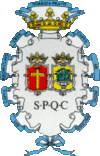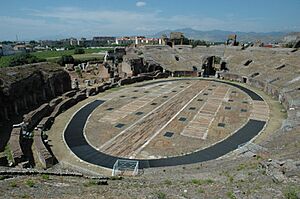Capua facts for kids
Quick facts for kids
Capua
|
||
|---|---|---|
| Comune di Capua | ||
 |
||
|
||
| Country | Italy | |
| Region | Campania | |
| Province | Caserta (CE) | |
| Frazioni | Sant'Angelo in Formis | |
| Area | ||
| • Total | 48.63 km2 (18.78 sq mi) | |
| Elevation | 25 m (82 ft) | |
| Population
(31 December 2017)
|
||
| • Total | 18,484 | |
| • Density | 380.09/km2 (984.44/sq mi) | |
| Demonym(s) | Capuani | |
| Time zone | UTC+1 (CET) | |
| • Summer (DST) | UTC+2 (CEST) | |
| Postal code |
81043
|
|
| Dialing code | 0823 | |
| Patron saint | St. Agatha | |
| Saint day | 5 February | |
Capua is a historic city in southern Italy. It is located in the province of Caserta, in the Campania region. The city is about 25 kilometers (15 miles) north of Naples. It sits on the edge of the Campanian plain.
Contents
History of Capua
Ancient Times
The name Capua comes from the Etruscan word Capeva. This means 'City of Marshes'. The city was founded by the Etruscans around 600 BC. This was when Etruscan power was very strong. Before the Etruscans, other groups like the Villanovians and Oscans lived here.
Around 424 BC, a group called the Samnites took over Capua. In 343 BC, Capua asked Rome for help against the Samnites. Capua and its nearby towns became allies with Rome. This meant that much of Campania came under Roman control. Capua's citizens gained Roman citizenship, but without the right to vote.
Capua was connected to Rome by the Appian Way in 312 BC. This was a very important military road. Capua grew in importance during the 3rd century BC. It was almost as big as Rome and Carthage.
During the Second Punic War, Capua sided with Hannibal against Rome. Hannibal even spent a winter there. After a long siege, the Romans captured Capua in 211 BC. The city was severely punished. Its leaders were removed, and its land became Roman property.
Later, Julius Caesar helped establish a Roman colony in Capua in 59 BC. About 20,000 Roman citizens moved there. Other emperors like Augustus and Nero also added more colonists. Capua was famous for its luxury and for training gladiators. The famous gladiator Spartacus and his followers came from Capua in 73 BC.
Middle Ages
A Christian church was built in Capua under Constantine I. In 456, the Vandals destroyed the city. It was rebuilt, but suffered again during the Gothic War. When the Lombards invaded Italy, Capua was damaged again. It became part of the Duchy of Benevento.
In 840, the old city of Capua was burned down by Saracens. Only the church of Santa Maria Maggiore remained. A new city was built in 856, a bit away from the old site. The old site became a new town called Santa Maria Capua Vetere ("Capua the Old").
Capua became a powerful principality. It was a rival to Salerno. In 1058, the Normans, led by Richard I, captured Capua. The city eventually became part of the kingdom of Sicily. In the 1230s, Emperor Frederick I built a large gate in Capua.
Modern Age
In 1799, during the French Revolutionary Wars, French forces attacked Capua. In 1860, the Battle of Volturnus (1860) took place in and around Capua. This battle was part of Garibaldi's plan to unite Italy. The Neapolitan army was defeated, and Capua was captured. Soon after, the people of Capua voted to join the new Kingdom of Italy.
Main Sights
Capua Cathedral
The Capua Cathedral is called Santo Stefano. It was built in 856. It has a tall bell tower and a beautiful inside. The church has old granite columns and a restored Romanesque crypt. You can see a fine paschal candlestick and pieces of a 13th-century pulpit. The cathedral also has old manuscripts with bronze and enamel decorations.
San Marcello Church
The small church of San Marcello was also built in 856. In the 1200s, Emperor Frederick II built a castle here. It was meant to guard the Roman bridge over the Volturnus River. The castle was taken down in 1557. Some of its statues are now in the Museo Campano.
Museo Campano
The Museo Campano is the Campania Provincial Museum of Capua. It was founded in 1870 and opened in 1874. This museum is a very important cultural spot for the whole region.
Archaeological Sites
Ancient Remains
Even though no pre-Roman buildings are left in Capua, many important cemeteries have been found. These date back to the 7th or 6th century BC. The tombs are different shapes, some with painted walls. Inside, archaeologists found bronze and clay vases.
East of the town, a temple was found with Etruscan writings. The most famous is the Tabula Capuana, a long Etruscan text. It is now in Berlin.
The town of Capua was built on a flat plain. It was laid out in a regular way. The main street ran from east to west. The Via Appia also passed through Capua.
Inside the town, you can find remains of old public baths and a theatre. The theatre was built after the time of Augustus. There is also a Mithraeum, which was a temple for the god Mithras.
Capua Amphitheatre
Outside the main town, in Santa Maria Capua Vetere, you can see the huge Amphitheatre of Capua. It was built during the time of Augustus and later improved by Hadrian. The outside had 80 arches on four levels, but only two arches remain today. The inside is better preserved. Underneath the arena, there are underground passages.
This amphitheatre is one of the largest in the world. It is 170 meters (558 feet) long and 140 meters (459 feet) wide. The arena itself is 75 by 45 meters (246 by 148 feet). For comparison, the Colosseum in Rome is 188 by 155 meters (617 by 509 feet).
| Colosseum (Rome, Italy) | 188 × 156 m |
| Capua (Italy) | 167 × 137 m |
| Italica (Spain) | 157 × 134 m |
| Tours (France) | 156 × 134 m |
| Carthage (Tunisia) | 156 × 128 m |
| Autun (France) | 154 × 130 m |
| Nîmes (France) | 133 × 101 m |
East of the amphitheatre, an old road called the Via Dianae leads to the Pagus Dianae. This was a community that grew around the famous temple of Diana. The site is now home to the Benedictine church of San Michele Arcangelo in Sant'Angelo in Formis. This church has interesting paintings from the 11th and 12th centuries.
Capua was a very important road center in Campania. Roads connected it to places like Puteoli, Cumae, and Naples.
See also
- History of Santa Maria Capua Vetere
- Archdiocese of Capua
- Battle of Capua
- Capua Leg
- Seconda Università degli Studi di Napoli
- Siege of Capua (211 BC)
- Coinage of Capua
Sources
 This article incorporates text from a publication now in the public domain: "Capua". Catholic Encyclopedia. (1913). New York: Robert Appleton.
This article incorporates text from a publication now in the public domain: "Capua". Catholic Encyclopedia. (1913). New York: Robert Appleton.



